Short-Term Impact of Multi-Cropping on Some Soil Physical Properties and Respiration
Abstract
:1. Introduction
2. Materials and Methods
2.1. Experiment Location, Time, Treatments
2.2. Experimental Conditions
2.2.1. Soil Characteristics
2.2.2. Agro-Technics
2.2.3. Meteorological Conditions
2.3. Methods and Analysis
3. Results and Discussion
3.1. Soil Penetration Resistance
3.2. Soil Aggregation and Stability
3.3. Soil Gas Concentration and Respiration
4. Conclusions
Author Contributions
Funding
Institutional Review Board Statement
Informed Consent Statement
Data Availability Statement
Acknowledgments
Conflicts of Interest
References
- Mao, G.; Huang, N.; Chen, L.; Wang, H. Research on biomass energy and environment from the past to the future: A bibliometric analysis. Sci. Total Environ. 2018, 635, 1081–1090. [Google Scholar] [CrossRef]
- Bhutto, A.W.; Bazmi, A.A.; Karim, S.; Abro, R.; Mazari, S.A.; Nizamuddin, S. Promoting sustainability of use of biomass as energy resource: Pakistan’s perspective. Environ. Sci. Pollut. Res. 2019, 26, 29606–29619. [Google Scholar] [CrossRef]
- Bielski, S.; Marks-Bielska, R.; Zielińska-Chmielewska, A.; Romaneckas, K.; Šarauskis, E. Importance of Agriculture in Creating Energy Security—A Case Study of Poland. Energies 2021, 14, 2465. [Google Scholar] [CrossRef]
- Dolle, K.; Kurzmann, D.E. Cannabis, the Plant of the Unlimited Possibilities. Adv. Res. 2019, 20, 1–22. [Google Scholar] [CrossRef]
- Franco, J.G.; King, S.R.; Masabni, J.G.; Volder, A. Plant functional diversity improves short-term yields in a low-input intercropping system. Agric. Ecosyst. Environ. 2015, 203, 1–10. [Google Scholar] [CrossRef]
- Brooker, R.W.; Bennett, A.E.; Cong, W.-F.; Daniell, T.J.; George, T.S.; Hallett, C.H.; Iannetta, P.P.M.; Jones, H.G.; Karley, A.J.; Li, L.; et al. Improving intercropping: A synthesis of research in agronomy, plant physiology and ecology. New Phytol. 2015, 206, 107–117. [Google Scholar] [CrossRef] [PubMed]
- Wang, J.; Lu, X.; Zhang, J.; Wei, H.; Li, M.; Lan, N.; Luo, H. Intercropping perennial aquatic plants with rice improved paddy field soil microbial biomass, biomass carbon and biomass nitrogen to facilitate soil sustainability. Soil Tillage Res. 2021, 208, 104908. [Google Scholar] [CrossRef]
- Gliessman, S.R.; Rosemeyer, M. The Conversion to Sustainable Agriculture: Principles, Processes and Practices; Taylor and Francis Group: Abingdon-on-Thames, Oxfordshire, UK, 2010; pp. 303–315. [Google Scholar]
- Heuermann, D.; Gentsch, N.; Boy, J. Interspecific competition among catch crops modifies vertical root biomass distribution and nitrate scavenging in soils. Sci. Rep. 2019, 9, 11531. [Google Scholar] [CrossRef] [Green Version]
- Smith, R.G.; Atwood, L.W.; Warren, N.D. Increased productivity of a cover crop mixture is not associated with enhanced agroecosystem services. PLoS ONE 2014, 9, e97351. [Google Scholar]
- Hayden, Z.D.; Ngouajio, M.; Brainard, D.C. Rye–vetch mixture proportion tradeoffs: Cover crop productivity, nitrogen accumulation, and weed suppression. Agron. J. 2014, 106, 904–914. [Google Scholar] [CrossRef]
- Kumar, R.; Pandey, S.; Pandey, A. Plant roots and carbon sequestration. Curr. Sci. 2006, 91, 885–890. [Google Scholar]
- Gill, S.; Abid, M.; Azam, F. Mixed cropping effects on growth of wheat (Triticum aestivum L.) and chickpea (Cicer arietenum L.). Pak. J. Bot. 2009, 41, 1029–1036. [Google Scholar]
- Fageria, N.K.; Baligar, V.C.; Bailey, B.A. Role of cover crops in improving soil and row crop productivity. Commun. Soil Sci. Plant Anal. 2005, 36, 2733–2757. [Google Scholar] [CrossRef]
- Yan, M.-C.; Xu, T.-T.; Song, P.-H.; Dai, J.-J. Effects of Different Cropping Patterns of Soybean and Maize Seedlings on Soil Enzyme Activities and MBC and MBN. J. Northeast Agric. Univ. 2012, 19, 42–47. [Google Scholar]
- Picasso, V.D.; Brummer, E.C.; Liebman, M.; Dixon, P.M.; Wilsey, B.J. Crop Species Diversity Affects Productivity and Weed Suppression in Perennial Polycultures under Two Management Strategies. Crop Sci. 2008, 48, 331–342. [Google Scholar] [CrossRef]
- Boudreau, M.A. Diseases in Intercropping Systems. Annu. Rev. Phytopathol. 2013, 51, 499–519. [Google Scholar] [CrossRef] [PubMed]
- Robačer, M.; Canali, S.; Lakenborg, K.H.; Baver, F.; Grobelnik, M.S.; Jakopa, M.; Bavec, M. Cover crops in organic field vegetable production. Sci. Hortic. 2016, 208, 104–110. [Google Scholar] [CrossRef]
- Nugis, E. Seedbed quality preparation in Estonia. Agron. Res. 2010, 8, 421–426. [Google Scholar]
- Romaneckas, K.; Šarauskis, E. The investigation by the Kritz method of sugar beet seedbed under different soil tillage and sowing patterns in Lithuania. In Proceedings of the Soil Management for Sustainability: International Soil Tillage Research Organization 16th Triennial Conference, Brisbane, Australia, 14–18 July 2003; pp. 1029–1035. [Google Scholar]
- Dürr, C.; Aubertot, J.N.; Richard, G.; Dubrulle, P.; Duval, Y.; Boiffin, J. A model for simulation of plant emergence predicting the effect of soil tillage and sowing operations. Soil Sci. Soc. Am. J. 2001, 65, 414–423. [Google Scholar] [CrossRef]
- Håkansson, I.; Arvidsson, J.; Rydberg, T. Effects of seedbed properties on crop emergence: 2. Effects of aggregate size, sowing depth and initial water content under dry weather conditions. Acta Agric. Scand. B Soil Plant Sci. 2011, 61, 469–479. [Google Scholar] [CrossRef]
- Seidel, E.P.; dos Reis, W.; Mottin, M.C. Effects of surface application of gypsum in corn intercropped with jack bean (’Canavalia eusiformis’) with different soil penetration resistance. Aust. J. Crop Sci. 2016, 10, 985–989. [Google Scholar] [CrossRef]
- Seidel, E.P.; Anschau, K.A.; Achre, D.; Mottin, M.C.; Lerner, K.L.; Vengen, A.P.; Franscziskowski, M.A.; Mattei, E. Physical properties of soil and productivity of maize intercropped with different cover plants. Afr. J. Agric. Res. 2017, 12, 2940–2945. [Google Scholar] [CrossRef] [Green Version]
- Pedrotti, A.I.; Aciole, F.M.S.; Silva, T.O.; Oliveira, A.E.S.; Dória, C.J.R.; Souza, J.C.; Ferreira, O.J.M.; Pauletto, E.A. Relations between Tillage Systems and Cultures in Succession on the Mechanical Resistance to Penetration on the Productivity of Sweet Corn at the End of Ten Years, in the Brazilian Northeast. In Agro Environ 2012, Proceedings of 8th International Symposium, Wageningen, The Netherlands, 1–4 May 2012. Available online: https://library.wur.nl/ojs/index.php/AE2012/article/view/12515/12600 (accessed on 5 November 2021).
- Thériault, L.; Dessureault-Rompré, I.; Caron, J. Short-Term Improvement in Soil Physical Properties of Cultivated Histosols through Deep-Rooted Crop Rotation and Subsoiling. J. Agron. 2019, 111, 2084–2096. [Google Scholar] [CrossRef]
- Latif, M.A.; Mehuys, G.R.; Mackenzie, A.F.; Alli, I.; Faris, M.A. Effects of legumes on soil physical quality in a maize crop. Plant Soil 1992, 140, 15–23. [Google Scholar] [CrossRef]
- Nunes, M.R.; Karlen, D.L.; Moorman, T.B. Tillage Intensity Effects on Soil Structure Indicators—A US Meta-Analysis. Sustainability 2020, 12, 2071. [Google Scholar] [CrossRef] [Green Version]
- Harrison-Kirk, T.; Beare, M.H.; Meenken, E.D.; Condron, L.M. Soil organic matter and texture affect responses to dry/wet cycles: Effects on carbon dioxide and nitrous oxide emissions. Soil Biol. Biochem. 2013, 57, 43–55. [Google Scholar] [CrossRef]
- Lenka, N.K.; Lal, R. Soil aggregation and greenhouse gas flux after 15 years of wheat straw and fertilizer management in a no-till system. Soil Tillage Res. 2013, 126, 78–89. [Google Scholar] [CrossRef]
- Paul, B.K.; Vanlauwe, B.; Ayuke, F.; Gassner, A.; Hoogmoed, M.; Hurisso, T.T.; Koala, S.; Lelei, D.; Ndabamenye, T.; Six, J.; et al. Medium-term impact of tillage and residue management on soil aggregate stability, soil carbon and crop productivity. Agric. Ecosyst. Environ. 2013, 164, 14–22. [Google Scholar] [CrossRef]
- Kurganova, I.; De Gerenyu, V.L.; Rozanova, L.; Sapronov, D.; Myakshina, T.; Kudeyarov, V. Annual and seasonal CO2 fluxes from Russian southern taiga soils. Tellus Ser. B Chem. Phys. Meteorol. 2003, 55, 338–344. [Google Scholar] [CrossRef]
- Shutao, C.; Jianwen, Z.; Zhenghua, H.; Haishan, C.; Yanyu, L. Global annual soil respiration in relation to climate, soil properties and vegetation characteristics: Summary of available data. Agric. For. Meteorol. 2014, 198–199, 335–346. [Google Scholar]
- Gelybó, G.; Barcza, Z.; Dencső, M.; Potyó, I.; Kása, I.; Horel, Á.; Pokovai, K.; Birkás, M.; Kern, A.; Hollós, R.; et al. Effect of tillage and crop type on soil respiration in a long-term field experiment on chernozem soil under temperate climate. Soil Tillage Res. 2022, 216, 105239. [Google Scholar] [CrossRef]
- Buragienė, S.; Šarauskis, E.; Romaneckas, K.; Adamavičienė, A.; Kriaučiūnienė, Z.; Avižienytė, D.; Marozas, V.; Naujokienė, V. Relationship between CO2 emissions and soil properties of differently tilled soils. Sci. Total Environ. 2019, 662, 786–795. [Google Scholar] [CrossRef]
- Fang, C.; Moncrieff, J.B. The dependence of soil CO2 efflux on temperature. Soil Biol. Biochem. 2001, 33, 155–165. [Google Scholar] [CrossRef]
- Fu, G.; Shen, Z.-X. Asymmetrical warming of growing/non-growing season increases soil respiration during growing season in an alpine meadow. Sci. Total Environ. 2022, 812, 152591. [Google Scholar] [CrossRef]
- Jian, J.; Bahn, M.; Wang, C.; Bailey, V.L.; Bond-Lamberty, B. Prediction of annual soil respiration from its flux at mean annual temperature. Agric. For. Meteorol. 2020, 287, 107961. [Google Scholar] [CrossRef]
- Peregrina, F. Surface soil properties influence carbon oxide pulses after precipitation events in a semiarid vineyard under conventional tillage and cover crops. Pedosphere 2016, 26, 499–509. [Google Scholar] [CrossRef]
- Melling, L.; Hatano, R.; Goh, K.J. Soil CO2 flux from three ecosystems in tropical peatland of Sarawak, Malaysia. Tellus Ser. B Chem. Phys. Meteorol. 2005, 57, 1–11. [Google Scholar] [CrossRef]
- Zhang, X.; Xin, X.; Yang, W.; Ding, D.; Ren, G.; Li, M.; Zhu, A. Soil respiration and net carbon flux response to long-term reduced/no-tillage with and without residues in a wheat-maize cropping system. Soil Tillage Res. 2021, 214, 105182. [Google Scholar] [CrossRef]
- Yang, X.D.; Ali, A.; Xu, Y.-L.; Jiang, L.-M.; Lv, G.-H. Soil moisture and salinity as main drivers of soil respiration across natural xeromorphic vegetation and agricultural lands in an arid desert region. Catena 2019, 177, 126–133. [Google Scholar] [CrossRef]
- Negassa, W.; Price, R.F.; Basir, A.; Snapp, S.S.; Kravchenko, A. Cover crop and tillage systems effect on soil CO2 and N2O fluxes in contrasting topographic positions. Soil Tillage Res. 2015, 154, 64–74. [Google Scholar] [CrossRef] [Green Version]
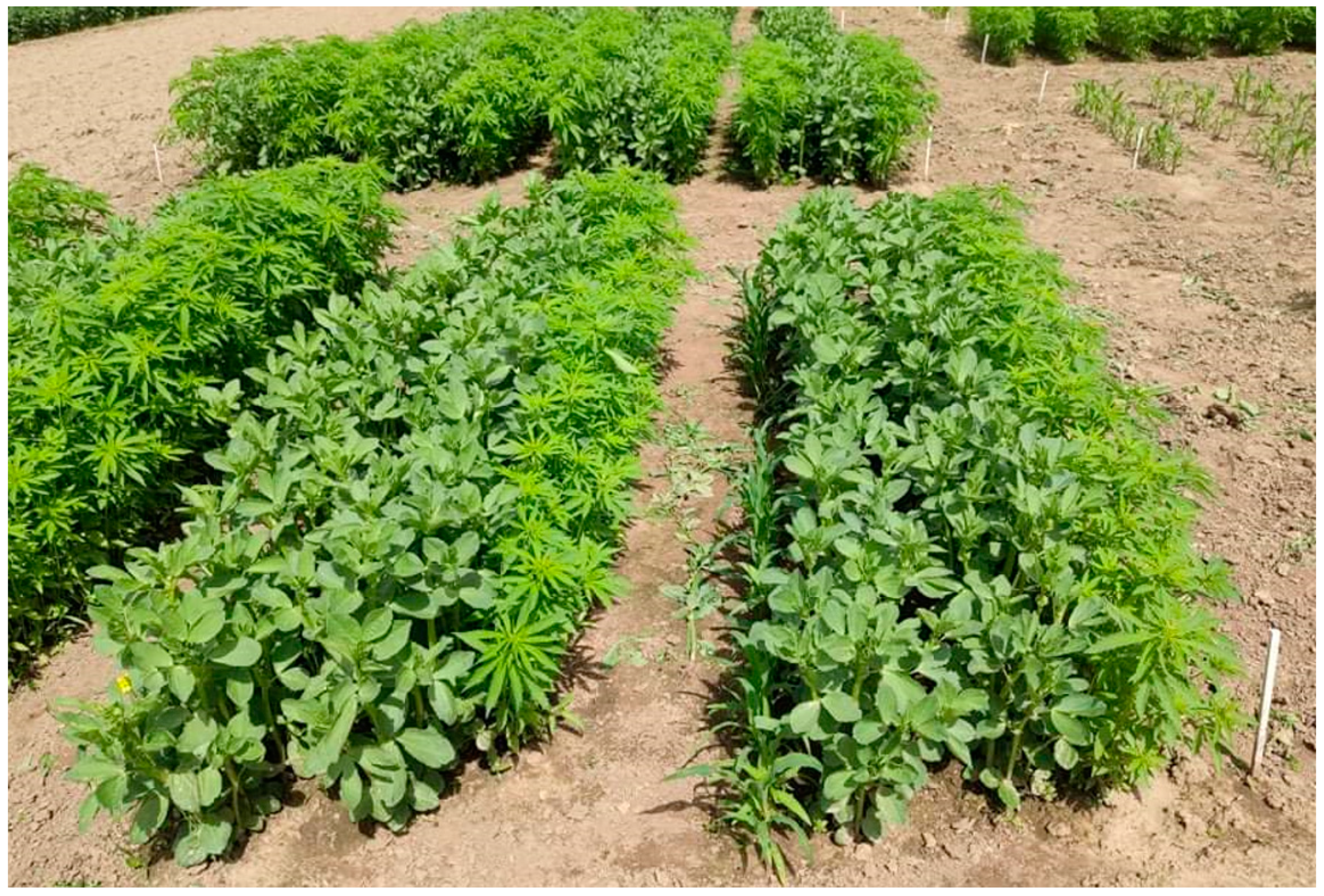
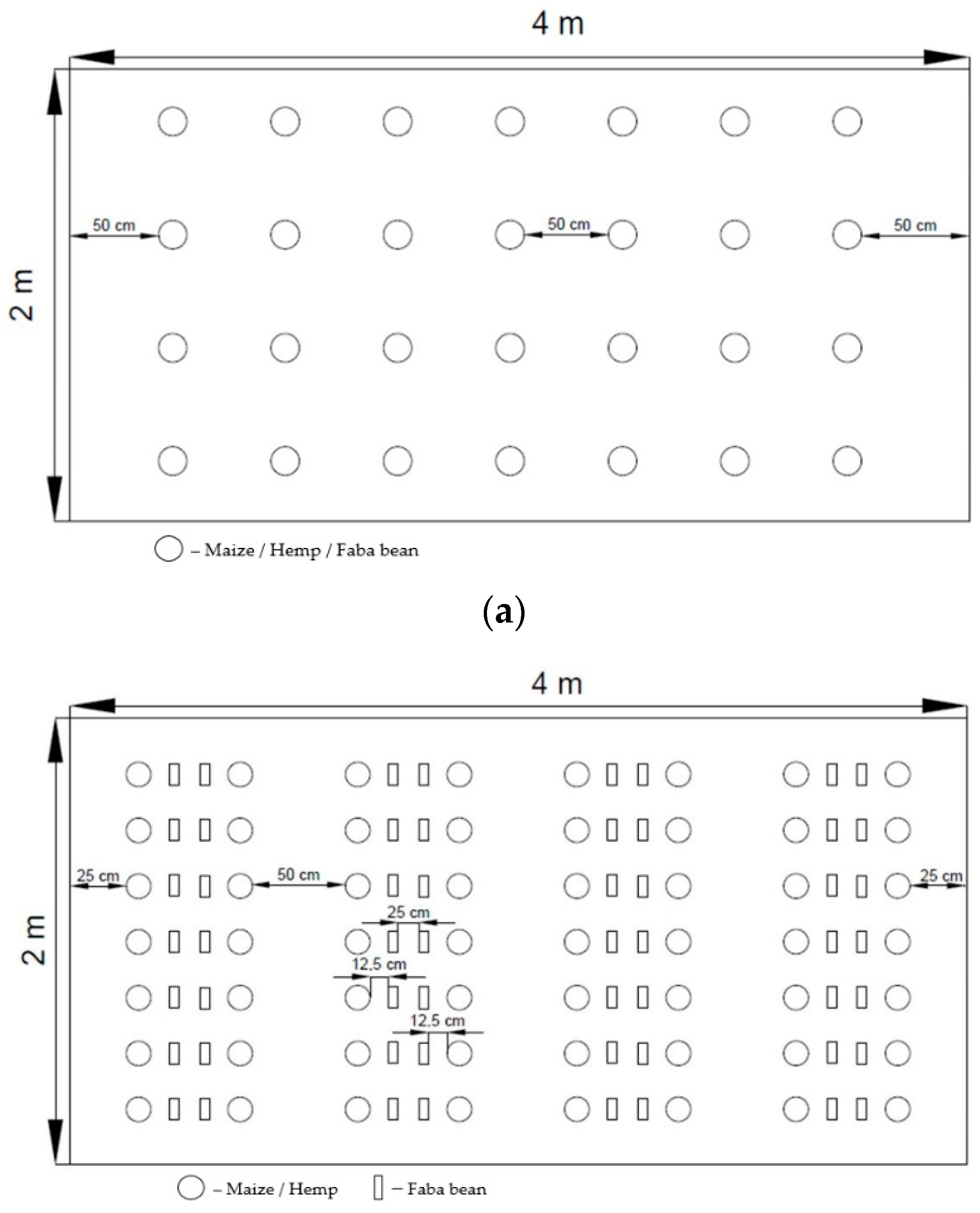

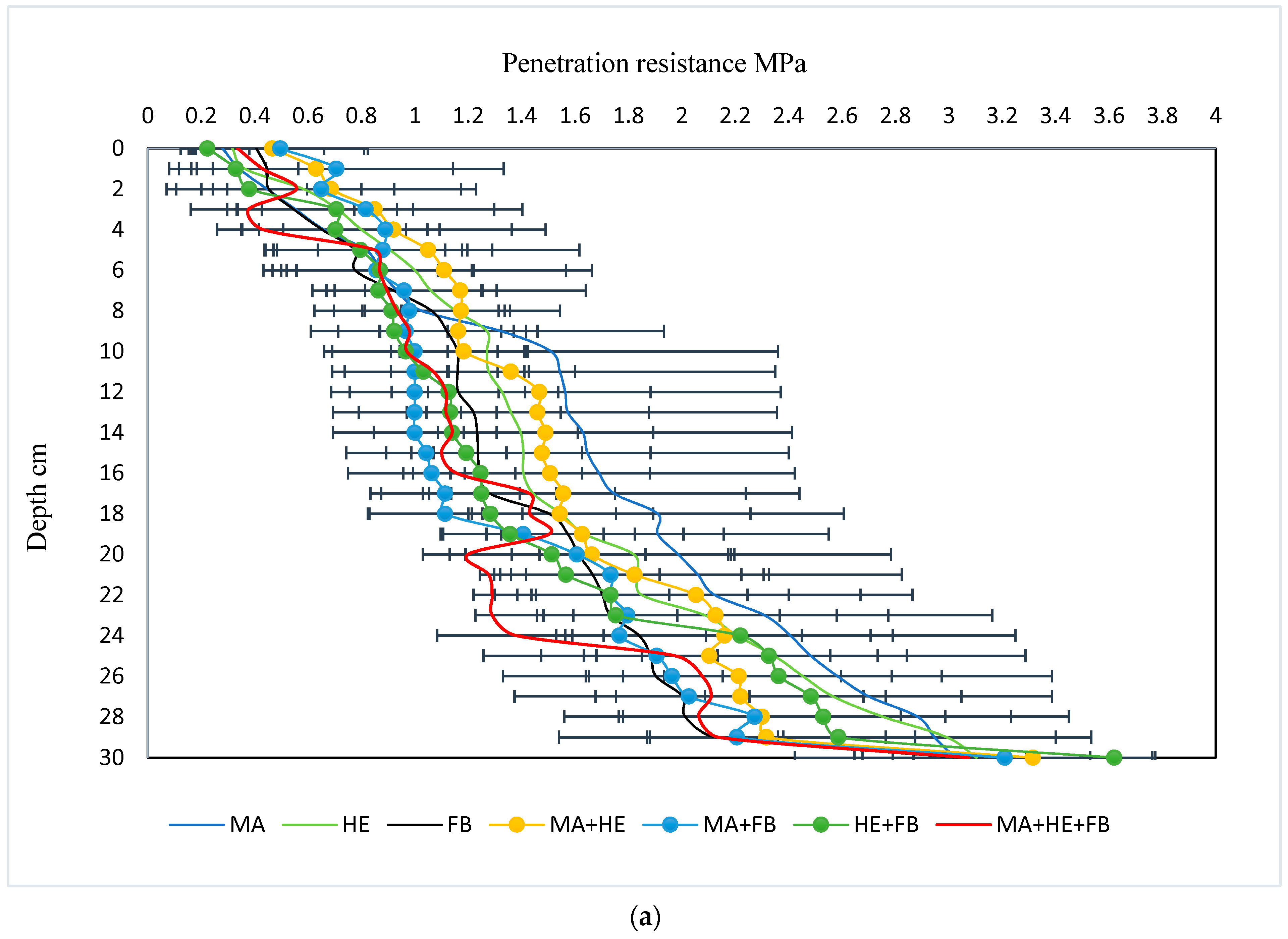
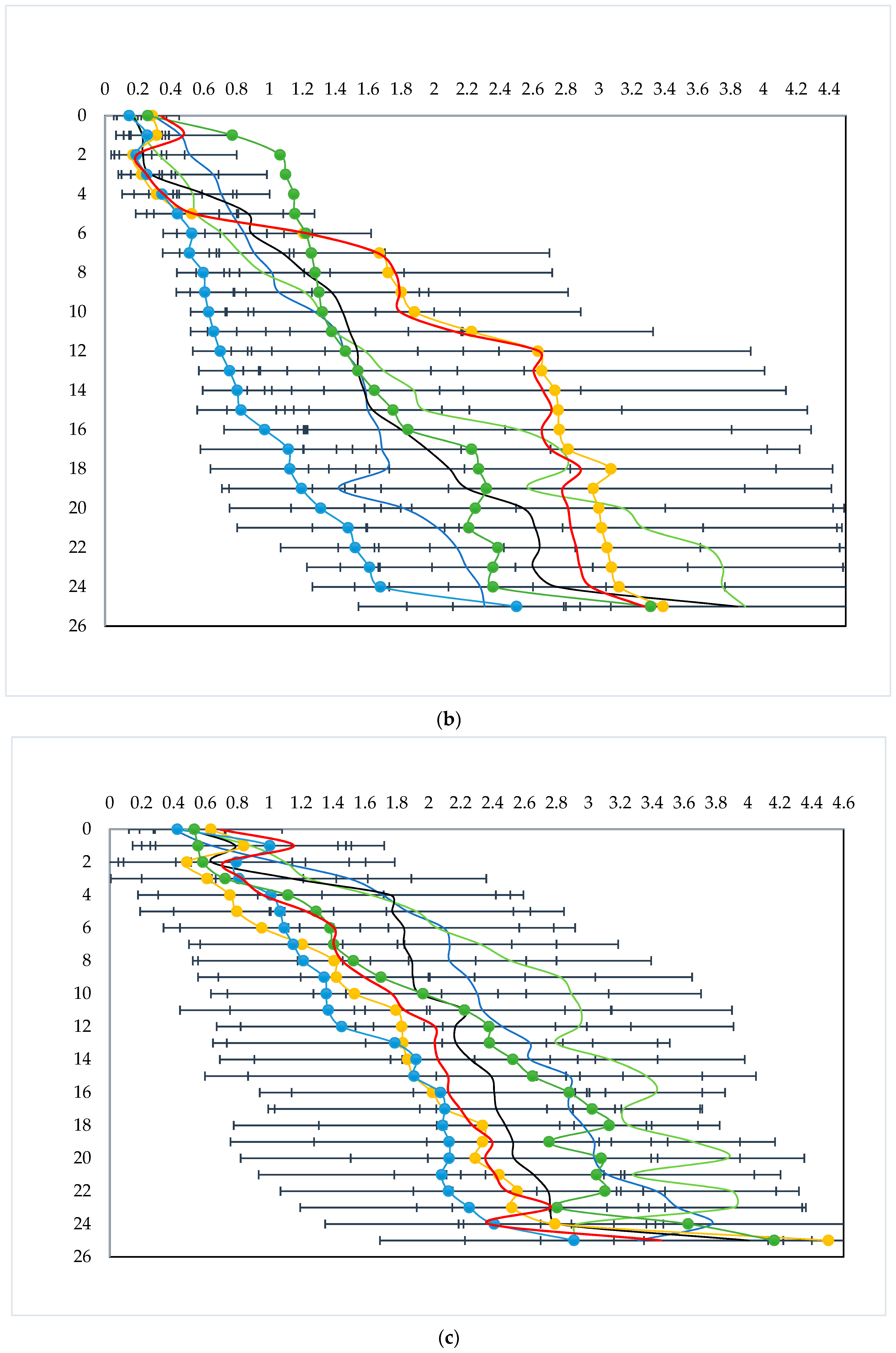
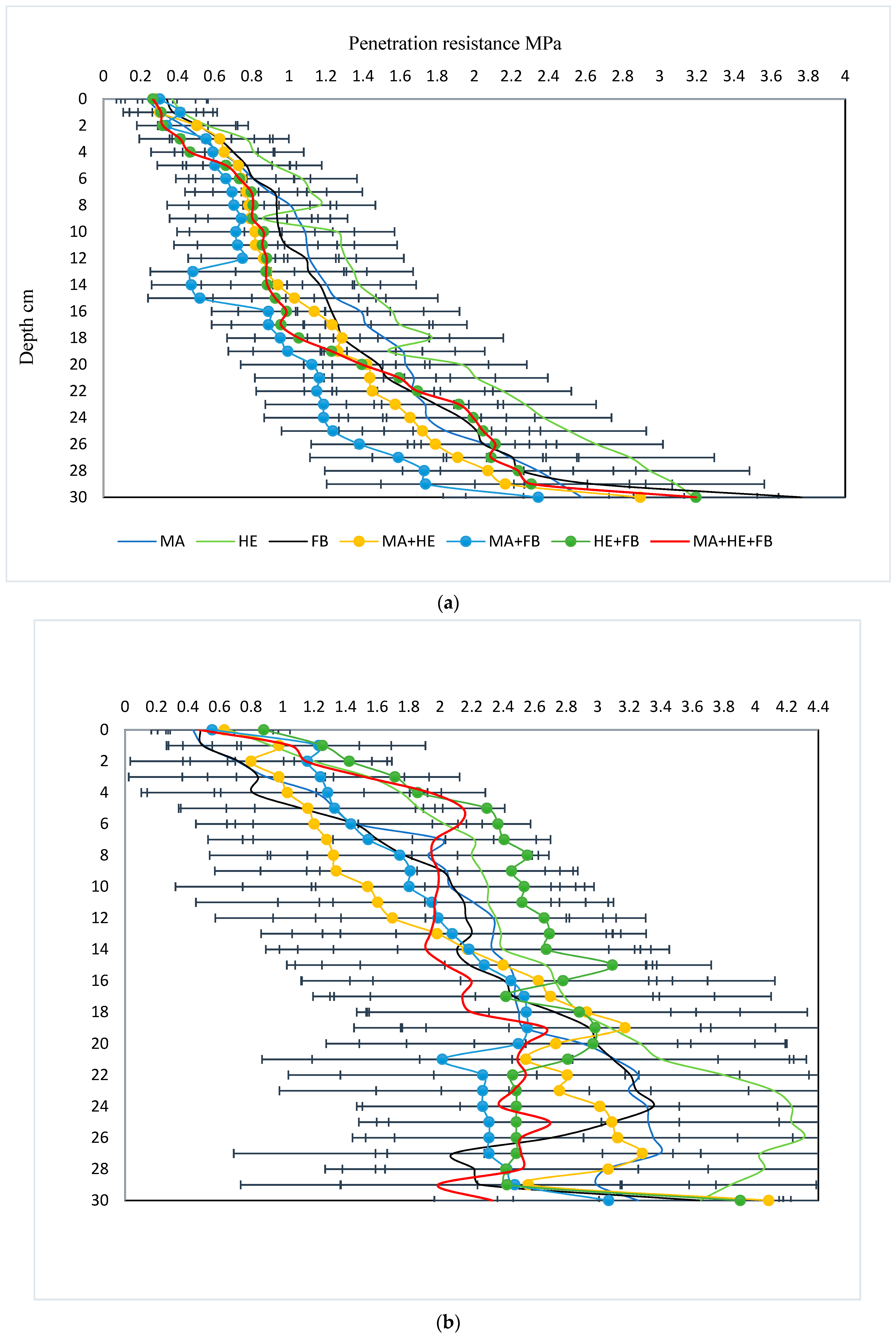

| Multi-Cropping Intensity | Cultivation | Abbreviation |
|---|---|---|
| mono-crop | maize | MA |
| hemp | HE | |
| faba bean | FB | |
| binary-crop | maize + hemp | MA + HE |
| maize + faba bean | MA + FB | |
| hemp + faba bean | HE + FB | |
| ternary-crop | maize + hemp + faba bean | MA + HE + FB |
| Months | 2020 | 2021 | Long-Term (Since 1974) Average |
|---|---|---|---|
| Air temperature °C | |||
| April | 6.9 | 6.2 | 6.9 |
| May | 10.5 | 11.4 | 13.2 |
| June | 19.0 | 19.5 | 16.1 |
| July | 17.4 | 22.6 | 18.7 |
| August | 18.7 | 16.5 | 17.3 |
| Rainfall mm | |||
| April | 4.0 | 33.7 | 41.3 |
| May | 94.4 | 121.6 | 61.7 |
| June | 99.3 | 40.3 | 76.9 |
| July | 60.4 | 48.4 | 96.6 |
| August | 92.8 | 122.2 | 88.9 |
| Multi-Cropping | Soil Structure, % | |||
|---|---|---|---|---|
| Mega | Macro | Micro | Stability | |
| beginning of vegetative season (2020) | ||||
| MA | 20.7 a | 70.1 a | 9.2 a | 51.8 a |
| HE | 21.5 a | 68.4 a | 10.2 a | 57.9 a |
| FB | 21.8 a | 69.3 a | 8.9 a | 54.2 a |
| MA + HE | 16.9 a | 73.6 a | 9.6 a | 59.1 a |
| MA + FB | 21.6 a | 69.5 a | 9.0 a | 53.7 a |
| HE + FB | 23.0 a | 68.4 a | 8.6 a | 55.8 a |
| MA + HE + FB | 21.7 a | 69.2 a | 9.1 a | 55.8 a |
| end of vegetative season (2020) | ||||
| MA | 25.4 a | 69.5 a | 5.1 a | 43.8 a |
| HE | 23.6 a | 69.0 a | 7.5 a | 47.9 a |
| FB | 29.9 a | 66.2 a | 3.9 a | 40.7 a |
| MA + HE | 27.6 a | 64.2 a | 8.3 a | 46.1 a |
| MA + FB | 28.9 a | 65.7 a | 5.4 a | 49.5 a |
| HE + FB | 29.4 a | 61.4 a | 9.2 a | 51.6 a |
| MA + HE + FB | 28.7 a | 65.0 a | 6.3 a | 47.0 a |
| beginning of vegetative season (2021) | ||||
| MA | 37.9 a | 59.1 a | 3.1 a | 38.5 a |
| HE | 40.0 a | 57.2 a | 2.8 a | 45.4 a |
| FB | 46.8 a | 51.5 a | 1.7 a | 41.3 a |
| MA + HE | 31.9 a | 65.3 a | 2.7 a | 35.8 a |
| MA + FB | 33.7 a | 63.5 a | 2.8 a | 35.2 a |
| HE + FB | 38.8 a | 58.8 a | 2.5 a | 35.5 a |
| MA + HE + FB | 37.5 a | 59.8 a | 2.7 a | 40.7 a |
| end of vegetative season (2021) | ||||
| MA | 21.7 a | 75.1 a | 3.2 a | 30.3 a |
| HE | 24.4 a | 70.9 ab | 4.7 a | 30.5 a |
| FB | 33.3 a | 64.4 ab | 2.3 a | 27.1 a |
| MA + HE | 36.9 a | 60.0 ab | 3.1 a | 30.4 a |
| MA + FB | 28.3 a | 67.8 ab | 3.9 a | 28.6 a |
| HE + FB | 39.5 a | 57.7 b | 2.8 a | 30.0 a |
| MA + HE + FB | 38.3 a | 59.1 ab | 2.6 a | 27.8 a |
| Multi-Cropping | CO2 Concentration % | O2 Concentration % | CO2 Respiration Rate μmol m−2 s−1 | Soil Moisture Content % | Soil Temperature °C |
|---|---|---|---|---|---|
| beginning of vegetative season | |||||
| MA | 0.050 a | 11.400 a | 1.940 a | 13.82 a | 17.55 ab |
| HE | 0.110 ab | 11.397 a | 2.327 a | 14.32 a | 17.36 ab |
| FB | 0.307 ab | 11.347 a | 2.887 a | 13.51 a | 17.93 ab |
| MA + HE | 0.050 a | 11.430 a | 2.140 a | 14.04 a | 17.92 ab |
| MA + FB | 0.240 ab | 11.423 a | 1.680 a | 13.45 a | 16.91 a |
| HE + FB | 0.947 b | 11.000 a | 2.537 a | 14.57 a | 17.84 ab |
| MA + HE + FB | 0.050 a | 11.513 a | 2.373 a | 14.60 a | 18.37 b |
| middle of vegetative season | |||||
| MA | 0.830 a | 9.110 a | 7.363 a | 16.87 a | 20.37 a |
| HE | 0.603 a | 9.183 a | 5.880 a | 14.77 a | 22.13 a |
| FB | 0.430 a | 9.233 a | 3.863 a | 15.86 a | 22.20 a |
| MA + HE | 0.490 a | 9.213 a | 5.043 a | 14.75 a | 22.15 a |
| MA + FB | 0.230 a | 9.257 a | 4.123 a | 15.21 a | 22.17 a |
| HE + FB | 0.153 a | 9.257 a | 5.057 a | 14.46 a | 21.98 a |
| MA + HE + FB | 0.240 a | 9.287 a | 4.723 a | 15.17 a | 22.05 a |
| end of vegetative season | |||||
| MA | 0.117 a | 8.010 a | 21.37 a | 18.23 a | |
| HE | 0.080 a | 8.020 a | 22.90 a | 17.93 a | |
| FB | 0.113 a | 8.053 a | 19.67 a | 17.97 a | |
| MA + HE | 0.163 a | 8.007 a | - | 19.63 a | 18.13 a |
| MA + FB | 0.080 a | 8.043 a | 23.67 a | 18.07 a | |
| HE + FB | 0.143 a | 8.060 a | 18.13 a | 18.73 a | |
| MA + HE + FB | 0.140 a | 8.057 a | 21.43 a | 18.17 a | |
| Variables | Soil Temperature °C | Soil Moisture Content % | CO2 Concentration % | O2 Concentration % | CO2 Respiration μmol m−2 s−1 |
|---|---|---|---|---|---|
| beginning of vegetative season | |||||
| Soil temperature °C | 1.000 | 0.545 | n | n | 0.640 |
| Soil moisture content % | - | 1.000 | n | n | n |
| CO2 concentration % | - | - | 1.000 | −0.957 ** | 0.378 |
| O2 concentration % | - | - | - | 1.000 | −0.359 |
| middle of vegetative season | |||||
| Soil temperature °C | 1.000 | −0.793 * | −0.694 | 0.787 * | −0.848 * |
| Soil moisture content % | - | 1.000 | 0.654 | −0.633 | 0.454 |
| CO2 concentration % | - | - | 1.000 | −0.954 ** | 0.775 * |
| O2 concentration % | - | - | - | 1.000 | −0.853 * |
| end of vegetative season | |||||
| Soil temperature °C | 1.000 | −0.635 | 0.513 | 0.350 | - |
| Soil moisture content % | - | 1.000 | −0.782 * | n | |
| CO2 concentration % | - | - | 1.000 | n | |
| O2 concentration % | - | - | - | 1.000 | |
| Multi-Cropping | CO2 Concentration % | O2 Concentration % | CO2 Respiration Rate μmol m−2 s−1 | Soil Moisture Content % | Soil Temperature °C |
|---|---|---|---|---|---|
| beginning of vegetative season | |||||
| MA | 2.067 b | 15.303 b | 2.865 a | 14.84 a | 17.94 a |
| HE | 0.567 a | 3.405 a | 2.267 a | 13.60 a | 17.68 a |
| FB | 0.777 ab | 7.968 ab | 1.832 a | 14.03 a | 17.56 a |
| MA + HE | 1.343 ab | 9.304 ab | 2.545 a | 14.22 a | 17.53 a |
| MA + FB | 0.760 ab | 8.234 ab | 1.778 a | 14.04 a | 17.72 a |
| HE + FB | 0.983 ab | 8.733 ab | 2.723 a | 13.74 a | 18.21 a |
| MA + HE + FB | 0.483 a | 4.330 a | 1.857 a | 13.83 a | 17.28 a |
| middle of vegetative season | |||||
| MA | 0.663 a | 22.333 a | 4.928 a | 14.42 a | 22.28 a |
| HE | 0.833 a | 22.172 a | 5.565 a | 17.10 a | 20.38 a |
| FB | 0.870 a | 23.000 a | 5.837 a | 15.98 a | 22.25 a |
| MA + HE | 0.550 a | 21.634 a | 5.655 a | 14.12 a | 22.16 a |
| MA + FB | 0.597 a | 22.803 a | 4.682 a | 15.19 a | 22.09 a |
| HE + FB | 0.460 a | 21.933 a | 4.192 a | 14.77 a | 21.99 a |
| MA + HE + FB | 1.140 a | 22.234 a | 5.208 a | 15.50 a | 22.15 a |
| end of vegetative season | |||||
| MA | 0.880 a | 19.000 a | 4.587 a | 12.73 a | 15.83 a |
| HE | 0.588 a | 19.001 a | 2.977 a | 12.71 a | 16.34 ab |
| FB | 1.167 a | 19.073 a | 3.833 a | 14.34 a | 17.49 b |
| MA + HE | 1.147 a | 18.974 a | 2.417 a | 12.59 a | 15.75 a |
| MA + FB | 1.100 a | 18.904 a | 2.637 a | 14.12 a | 15.88 a |
| HE + FB | 0.823 a | 19.101 a | 1.957 a | 12.48 a | 16.86 ab |
| MA + HE + FB | 0.430 a | 19.069 a | 1.860 a | 14.03 a | 17.58 b |
| Variables | Soil Temperature °C | Soil Moisture Content % | CO2 Concentration % | O2 Concentration % | CO2 Respiration μmol m−2 s−1 |
|---|---|---|---|---|---|
| beginning of vegetative season | |||||
| Soil temperature °C | 1.000 | n | 0.444 | 0.507 | 0.673 |
| Soil moisture content % | - | 1.000 | 0.906 ** | 0.912 ** | 0.433 |
| CO2 concentration % | - | - | 1.000 | 0.943 ** | 0.767 * |
| O2 concentration % | - | - | - | 1.000 | 0.612 |
| middle of vegetative season | |||||
| Soil temperature °C | 1.000 | −0.764 * | n | n | n |
| Soil moisture content % | - | 1.000 | 0.557 | 0.392 | 0.385 |
| CO2 concentration % | - | - | 1.000 | 0.314 | 0.494 |
| O2 concentration % | - | - | - | 1.000 | n |
| end of vegetative season | |||||
| Soil temperature °C | 1.000 | 0.519 | -0.379 | 0.801* | n |
| Soil moisture content % | - | 1.000 | n | n | n |
| CO2 concentration % | - | - | 1.000 | −0.391 | 0.337 |
| O2 concentration % | - | - | - | 1.000 | n |
Publisher’s Note: MDPI stays neutral with regard to jurisdictional claims in published maps and institutional affiliations. |
© 2022 by the authors. Licensee MDPI, Basel, Switzerland. This article is an open access article distributed under the terms and conditions of the Creative Commons Attribution (CC BY) license (https://creativecommons.org/licenses/by/4.0/).
Share and Cite
Romaneckas, K.; Balandaitė, J.; Sinkevičienė, A.; Kimbirauskienė, R.; Jasinskas, A.; Ginelevičius, U.; Romaneckas, A.; Petlickaitė, R. Short-Term Impact of Multi-Cropping on Some Soil Physical Properties and Respiration. Agronomy 2022, 12, 141. https://doi.org/10.3390/agronomy12010141
Romaneckas K, Balandaitė J, Sinkevičienė A, Kimbirauskienė R, Jasinskas A, Ginelevičius U, Romaneckas A, Petlickaitė R. Short-Term Impact of Multi-Cropping on Some Soil Physical Properties and Respiration. Agronomy. 2022; 12(1):141. https://doi.org/10.3390/agronomy12010141
Chicago/Turabian StyleRomaneckas, Kęstutis, Jovita Balandaitė, Aušra Sinkevičienė, Rasa Kimbirauskienė, Algirdas Jasinskas, Ugnius Ginelevičius, Andrius Romaneckas, and Rita Petlickaitė. 2022. "Short-Term Impact of Multi-Cropping on Some Soil Physical Properties and Respiration" Agronomy 12, no. 1: 141. https://doi.org/10.3390/agronomy12010141
APA StyleRomaneckas, K., Balandaitė, J., Sinkevičienė, A., Kimbirauskienė, R., Jasinskas, A., Ginelevičius, U., Romaneckas, A., & Petlickaitė, R. (2022). Short-Term Impact of Multi-Cropping on Some Soil Physical Properties and Respiration. Agronomy, 12(1), 141. https://doi.org/10.3390/agronomy12010141










